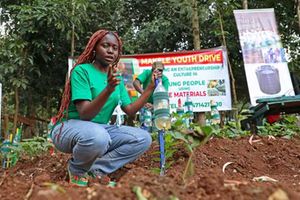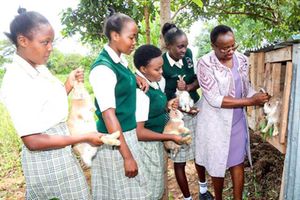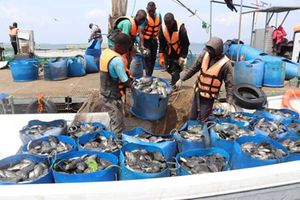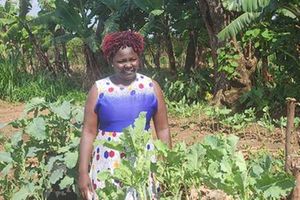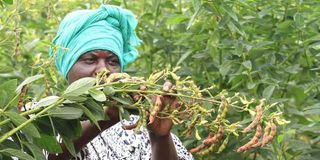
Rosina Muteti harvests pigeon peas at her farm in Nthongoni Village, Makueni County on April 23, 2025.
It is months before the pigeon pea harvesting season in Makueni County but Rosina Muteti and some of her neighbours are beaming with the excitement.
They are among the dozens of smallholder farmers in the semi-arid region who have benefited from an innovation by the Kenya Agricultural and Livestock Research Organization (Kalro), which has halved the time it takes for pigeon peas to mature.
“We no longer wait until August to enjoy pigeon peas. Harvesting now begins in April,” Muteti tells Seeds of Gold during a guided tour of her farm on the outskirts of Mtito Andei township.
A forest of pigeon pea bushes sagging under the weight of mature pods greets visitors.
Unlike many of her neighbours, Muteti grows pigeon peas in a pure stand.
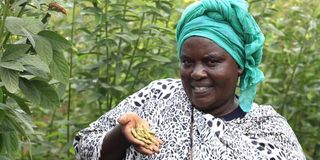
Rosina Muteti harvests pigeon peas at her farm in Nthongoni Village, Makueni County on April 23, 2025.
Telling from the neat rows and expected yields, she is the quintessential queen of the crop in the region.
“This is Mituki,” she says, referring to the early maturing pigeon pea variety developed by scientists at Kalro.
Mituki is among improved crop varieties developed at Kalro and the International Maize and Wheat Improvement Centre, with support from the European Union.
The aim of the programme is to enhance the resilience of smallholder farmers in Makueni and neighbouring regions due to the devastating effects of climate change.
The list includes varieties of amaranth, cow peas, fodder grass, millet, mung beans and sorghum.
According to Rael Karimi, a pigeon pea breeder at Kalro, it took the scientists multiple delicate crossings to develop the Mituki variety.
“Mituki is a medium maturing pigeon pea type that is also high-yielding. Kalro recommends a spacing of 50 centimetres between plants and 120 centimetres from row to row in a pure stand for maximum harvests. Mituki is also resistant to common pests and diseases,” Karimi says.
“An acre yields six to eight bags of dry pigeon peas, depending on the management of the crop.”
Nickson Mutinda, the seed manager at the Kalro Drylands Crops Station in Katumani, Machakos County, says Mituki is the latest pigeon pea variety in the market.
“It is inspired by an ingenious pigeon pea variety known as Kionza in Ukambani, which is known for big pods. We considered early maturity, long pods and big seeds when developing Mituki. These are some of the desirable attributes in pigeon peas that farmers and other stakeholders identified as we embarked on the journey that culminated in Mituki,” Mutinda tells Seeds of Gold.
Known scientifically as Cajanus cajan, the pigeon pea is a favourite vegetable and trading commodity when green.
Muteti is among a growing population of farmers and traders who has made a fortune by selling green pigeon peas to hotels, restaurants, open-air markets and households.
“A kilogramme of green pigeon peas goes for Sh100 in Kambu and Mtito Andei. The same fetches Sh200 in Mombasa,” Muteti says. “Because of this, Mituki has addressed my family’s food security concerns and improved my income.”
The early maturing pigeon pea variety ensures traders and farmers like Muteti dominate the market for at least three months before the glut in August.
Once the pigeon peas dry, they are mixed with maize and boiled to make a popular meal known as isyo.
In Mombasa and other coastal counties, pigeon pea is at the heart of Mbaazi za nazi, a delicacy served with mandazi mostly for breakfast.
It entails boiling dry pigeon peas mixed with coconut oil.
Shiploads of dry pigeon peas destined for India leave the port of Mombasa from early September.
Pigeon pea remains an important element in the Asian food system.
Kalro has teamed up with AgriTerra – an NGO that promotes drought-tolerant crops and sustainable agribusiness in Kajiado, Machakos and Makueni counties – to promote the early maturing pigeon pea variety.
“We are banking on smallholder farmers to meet the growing demand for Mituki seeds. Our target is at least 50 tonnes of seeds by September,” Mutinda says.
“This presents a big business opportunity for smallholder farmers.”
Muteti and other early Mituki adopters who have become champion farmers are at the centre of the campaign to promote the variety.
Kalro and AgriTerra organise field days to promote the variety, which has been hailed by agriculture experts as the key to fighting hunger in Makueni and neighbouring regions.
“When it comes to drought-tolerant crops, Mituki is the cherry on the cake. We are working with Kibwezi East Farmers’ Cooperative Society to promote this pigeon pea variety,” says Esther Kalanza, a cooperatives adviser at AgriTerra.
“We have linked the members with credible seed merchants and intend to make them credible seed merchants themselves.”
She spoke at recent field day in Maikuu Village – the centre of the Makueni County pigeon pea belt.

